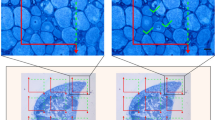Abstract
The aim of the present work was to obtain a quantitative evaluation of post-traumatic regeneration of nerve cells in the superior cervical ganglion (SCG) by measuring the ratio of the number of neurons (N) in the ganglion to the number of preganglionic myelinated fibers (F) in the cervical sympathetic trunk (N/F). This was addressed using light and electron microscopy. Studies were performed using white male rats divided into three groups: intact (aged seven months), age controls (aged 19 months), and experimental — one year after compression of the sympathetic trunk at the base of the SCG performed at age seven months. N/F in intact rats was 1:210. With age, N/F changed to 1:173; the value one year after trauma was 1:745. These data led to the conclusion that normalization of the structure of the neural connections of the ganglion did not occur. The process of post-traumatic regeneration was incomplete and became chronic.
Similar content being viewed by others
References
S. M. Blinkov and I. I. Glezera, The Human Brain in Numbers and Tables [in Russian], Meditsina, Leningrad (1964).
N. N. Bogolepov, Brain Ultrastructure in Hypoxia, Meditsina, Moscow (1979).
A. G. Velichanskaya, Structural Characteristics of the Sympathetic Ganglion of the White Rat in Normal Conditions and Post-Traumatic Regeneration [in Russian], Author’s Abstract of Master’s Thesis in Biological Sciences, Saransk (2004).
N. G. Kolosov and A. Ya. Khabarova, Structural Organization of Nerve Ganglia [in Russian], Nauka, Leningrad (1978).
D. É. Korzhevskii and V. A. Otellin, “Use of a silver staining method for nucleoli in assessing the state of the protein-synthesizing apparatus of nerve cells,” Tsitologiya, 35, No. 10, 20–23 (1993).
S. V. Lopatina, Characteristics of Capillary-Neurocellular Interactions of the Superior Cervical Ganglion [in Russian], Author’s Abstract of Master’s Thesis in Biological Sciences, Novosibirsk (2001).
A. D. Nozdrachev, Physiology of the Autonomic Nervous System [in Russian], Meditsina, Moscow (1983).
O. S. Sotnikov, “Non-myelinated nerve fibers,” Morfologiya, 123, No. 2, 88–96 (2003).
K. G. Tayushev, “Variants of histological studies of the nervous system in neurosurgical pathology,” Morfologiya, 106, No. 1–3, 20–29 (1994).
M. N. Umovist and Yu. B. Chaikovskii, “Current concepts of the structure and function of nerve coatings,” Arkh. Anat., 92, No. 1, 89–96 (1987).
Ya. E. Khesin, Nucleolar Size and the Functional State of the Cell [in Russian], Meditsina, Moscow (1967).
C. W. Bowers and R. E. Zigmond, “Localization of neurons in the rat superior cervical ganglion that project into different post-ganglionic trunks,” J. Comp. Neurol., 185, 381–391 (1979).
R. Brooks-Fournier and R. E. Coggeshall, “The ratio of preganglionic axons to postganglionic cells in the sympathetic nervous system of the rat,” J. Comp. Neurol., 197, 207–216 (1981).
S. E. Ebbesson, “Quantitative studies of superior cervical sympathetic ganglia in a variety of primates including man,” J. Morphol., 124, 117–131 (1968).
L. Klimachewski, “Increased innervation of rat preganglionic sympathetic neurons by substance P containing nerve fibers in response to spinal cord injury,” Neurosci. Lett., 307, No. 2, 73–76 (2001).
M. Lipschitz, “Thoracic sympathetic trunk compression by osteophytes associated with arthritis of the costovertebral joint. Anatomical and clinical considerations,” Acta Anat. (Basel), 132, No. 1, 48–54 (1988).
B. Pan and L. P. Schramm, “Increased close appositions between corticospinal tract axons and spinal sympathetic neurons after spinal cord injury in rats,” J. Neurotrauma, 22, No. 12, 1399–1410 (2005).
Author information
Authors and Affiliations
Corresponding author
Additional information
__________
Translated from Morfologiya, Vol. 132, No. 4, pp. 31–35 July–August, 2007.
Rights and permissions
About this article
Cite this article
Serebryakova, I.Y. Dynamics of the remodeling of neural connections in the superior cervical ganglion in rats after dosed compression of the preganglionic trunk. Neurosci Behav Physi 38, 811–815 (2008). https://doi.org/10.1007/s11055-008-9062-x
Received:
Revised:
Published:
Issue Date:
DOI: https://doi.org/10.1007/s11055-008-9062-x




